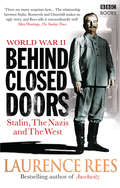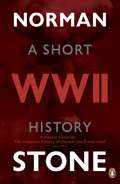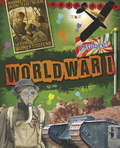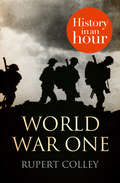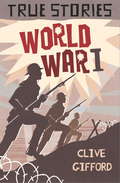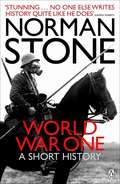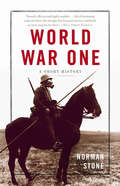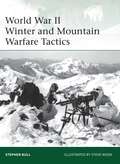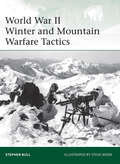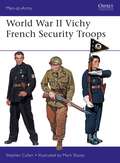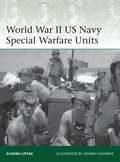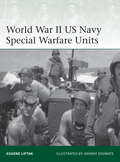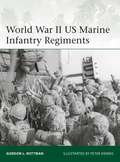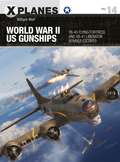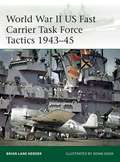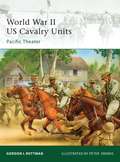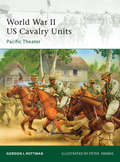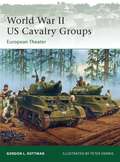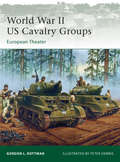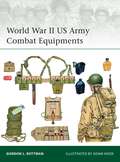- Table View
- List View
World War Two: Stalin, the Nazis and the West
by Laurence ReesWhen do you think the Second World War ended?If the end of the war was supposed to have brought 'freedom' to countries that suffered under Nazi occupation, then for millions it did not really end until the fall of Communism. In the summer of 1945 many of the countries in Eastern Europe simply swapped the rule of one tyrant, Adolf Hitler, for that of another: Joseph Stalin. Why this happened has remained one of the most troubling questions of the entire conflict, and is at the heart of Laurence Rees' dramatic book.In World War II: Behind Closed Doors, Rees provides an intimate 'behind the scenes' history of the West's dealings with Joseph Stalin - an account which uses material only available since the opening of archives in the East as well as new testimony from witnesses from the period. An enthralling mix of high politics and the often heart-rending personal experiences of those on the ground, it will make you rethink what you believe about World War II.
World War Two: A Short History
by Norman StoneA pacy, compelling and penetrating account from Wolfson Prize-winning author Norman Stone, that shows World War Two in a fresh new lightThe Second World War is the nightmare that sits at the heart of the modern era - a total refutation of any notion of human progress and a conflict which still haunts us seventy years on.Norman Stone's gripping new book aims to tell the narrative of the war in as brief a compass as possible, making a sometimes familiar story utterly fresh and arresting. As with his highly acclaimed World War One: A Short History, there is a compelling sense of a terrible story unfolding, of a sceptical and humorous intelligence at work, and a wish to convey to an audience who may well have no memory of the conflict just how high the stakes were.This is a beautifully written, clever and imaginative attempt to convey what can almost not be conveyed. About the author:Norman Stone is one of Britain's greatest historians. His major works include The Eastern Front, 1914-1917 (winner of the Wolfson Prize and published by Penguin), Europe Transformed and The Atlantic and Its Enemies (published by Penguin). He has taught at the universities of Cambridge, Oxford and Bilkent, where he is now Director of the Turkish-Russian Centre. He lives in Ankara.Reviews:'Professor Norman Stone has achieved the impossible; he has somehow written a comprehensive history of the Second World War in just under 200 pages, summarising the entire conflict while leaving out nothing of importance and bringing his lifetime of study of the subject to bear in a witty, incisive and immensely readable way ... Norman Stone has proved yet again that he is one of the most original, witty and powerful British historians writing today' Andrew Roberts, Standpoint'The joy and strength of this compact history, besides its trenchancy and, in the publishers' words, the "sceptical and humorous intelligence at work", is its narrative clarity ... a book to clear the mind after the grand tour of the big volumes' Allan Mallinson, The Times'Novices will receive a painless introduction, but educated readers should not pass up the highly opinionated prologue and epilogue and the author's trademark acerbic commentary throughout ... Readers of all stripes ... will find plenty to ponder' Kirkus Reviews
World War One Collection: Private Peaceful, A Medal for Leroy, Farm Boy
by Michael MorpurgoThree outstanding novels by the nation’s favourite storyteller that depict unforgettable experiences of WWI.
World War One: World War One (Explore! #8)
by Jane BinghamThis photographic book gives you an overview of World War One. From how the war began to how it spread worldwide, the new technology that was used in war for the first time, how women's roles changed in society because of the war, what life was like on the home front and how people recorded the war in paintings, poems and diaries. You can also find out how to send a message in Morse code.
World War One: History In An Hour (History In An Hour Ser.)
by Rupert ColleyLove history? Know your stuff with History in an Hour.
World War One: True Stories (True Stories)
by Clive GiffordThe book contains nine short stories dealing with different aspects of life during World War I.World War I includes the stories of flying aces such as the 'Red Baron', the story of Lawrence of Arabia and the stories of brave doctors and nurses such as Edith Cavell in German occupied Belgium.Complete with glossary, further reading section and index.
World War One: A Short History
by Norman StoneThe First World War was the overwhelming disaster from which everything else in the twentieth century stemmed. Fourteen million combatants died, a further twenty million were wounded, four empires were destroyed and even the victors' empires were fatally damaged. The sheer complexity and scale of the war have encouraged historians to write books on a similar scale. But now Norman Stone, one of Britain's greatest historians, has achieved the almost impossible task of writing a terse, brilliantly written, opinionated and witty short history of the conflict. In only 140 pages he distils a lifetime of teaching, arguing and thinking into what will be one of the most talked about history books of years to come.
World War One: A Short History
by Norman StoneThe First World War was the overwhelming disaster from which everything else in the twentieth century stemmed. Fourteen million combatants died, four empires were destroyed, and even the victors' empires were fatally damaged. World War I took humanity from the nineteenth century forcibly into the twentieth-and then, at Versailles, cast Europe on the path to World War II as well. In World War One, Norman Stone, one of the world's greatest historians, has achieved the almost impossible task of writing a terse and witty short history of the war. A captivating, brisk narrative, World War One is Stone's masterful effort to make sense of one of the twentieth century's pivotal conflicts.
World War II Winter and Mountain Warfare Tactics (Elite)
by Steve Noon Stephen BullThe twentieth century saw an unprecedented emphasis on fighting in all terrains, seasons and weather conditions. Such conditions made even basic survival difficult as subzero temperatures caused weapons to jam, engines to seize up and soldiers to suffer frostbite, snow blindness and hypothermia. The conditions often favoured small groups of mobile, lightly armed soldiers, rather than the armoured forces or air power that dominated other combat environments. Some European armies developed small numbers of specialist alpine troops before and during World War I, but these proved to be insufficient as nearly all the major combatants of World War II found themselves fighting for extended periods in extremely hostile cold-weather and/or alpine environments. Drawing upon manuals, memoirs and unit histories and illustrated with period tactical diagrams and specially commissioned full-colour artwork, this study sheds new light on the winter-warfare tactics and techniques of the US, British, German, Soviet and Finnish armies of World War II.
World War II Winter and Mountain Warfare Tactics (Elite Ser. #193)
by Steve Noon Stephen BullThe twentieth century saw an unprecedented emphasis on fighting in all terrains, seasons and weather conditions. Such conditions made even basic survival difficult as subzero temperatures caused weapons to jam, engines to seize up and soldiers to suffer frostbite, snow blindness and hypothermia. The conditions often favoured small groups of mobile, lightly armed soldiers, rather than the armoured forces or air power that dominated other combat environments. Some European armies developed small numbers of specialist alpine troops before and during World War I, but these proved to be insufficient as nearly all the major combatants of World War II found themselves fighting for extended periods in extremely hostile cold-weather and/or alpine environments. Drawing upon manuals, memoirs and unit histories and illustrated with period tactical diagrams and specially commissioned full-colour artwork, this study sheds new light on the winter-warfare tactics and techniques of the US, British, German, Soviet and Finnish armies of World War II.
World War II Vichy French Security Troops (Men-at-Arms #516)
by Mark Stacey Stephen M. CullenAfter the Fall of France in 1940, a new puppet state was set up in the south. Officially known as the French State, it is better known as Vichy France. This collaborationist Vichy regime's armed forces were more active and usually more numerous than German troops in the task of hunting down and crushing the maquis - the French Resistance guerrilla forces This book will cover the organization and operations of Vichy French Security Forces, including: the new Vichy Police Nationale, particularly their Groupes Mobiles de Reserve, the Service d'Ordre Légionnaire , and the Milice Francaise, a ruthless anti-Resistance militia armed partly with British weapons captured from SOE airdrops. Fully illustrated throughout with contemporary photographs and commissioned artwork, it tells the story of Occupied France from the perspective of those who sought to keep it in German hands.
World War II Vichy French Security Troops (Men-at-Arms #516)
by Mr Mark Stacey Dr Stephen M. CullenAfter the Fall of France in 1940, a new puppet state was set up in the south. Officially known as the French State, it is better known as Vichy France. This collaborationist Vichy regime's armed forces were more active and usually more numerous than German troops in the task of hunting down and crushing the maquis - the French Resistance guerrilla forces This book will cover the organization and operations of Vichy French Security Forces, including: the new Vichy Police Nationale, particularly their Groupes Mobiles de Reserve, the Service d'Ordre Légionnaire , and the Milice Francaise, a ruthless anti-Resistance militia armed partly with British weapons captured from SOE airdrops. Fully illustrated throughout with contemporary photographs and commissioned artwork, it tells the story of Occupied France from the perspective of those who sought to keep it in German hands.
World War II US Navy Special Warfare Units (Elite)
by Johnny Shumate Eugene LiptakWith the need for large-scale amphibious landings to decide the outcome of World War II the US Navy developed several types of specialized unit to reconnoitre potential landing areas, degrade the enemy's ability to resist, and assist the landing forces on to the beaches. The Scouts and Raiders were the forerunners of the SEALs, Beach Jumpers made elaborate simulated landings to distract the enemy, the Naval Combat Demolition Units and Underwater Demolition Teams cleared obstacles to amphibious landings and Naval Group China fought alongside Chinese guerrillas behind Japanese lines. This book uncovers the fascinating history of these units, the unique gear they went into theatre with and the vital roles they carried out throughout the war.
World War II US Navy Special Warfare Units (Elite #203)
by Johnny Shumate Eugene LiptakWith the need for large-scale amphibious landings to decide the outcome of World War II the US Navy developed several types of specialized unit to reconnoitre potential landing areas, degrade the enemy's ability to resist, and assist the landing forces on to the beaches. The Scouts and Raiders were the forerunners of the SEALs, Beach Jumpers made elaborate simulated landings to distract the enemy, the Naval Combat Demolition Units and Underwater Demolition Teams cleared obstacles to amphibious landings and Naval Group China fought alongside Chinese guerrillas behind Japanese lines. This book uncovers the fascinating history of these units, the unique gear they went into theatre with and the vital roles they carried out throughout the war.
World War II US Marine Infantry Regiments (Elite #222)
by Peter Dennis Gordon L. RottmanThe United States Marine Corps came into its own in the Pacific Islands campaign against Japan in World War II. From Guadalcanal to Okinawa, US Marines formed the tip of the spear as Allied forces sought to push the Japanese back to their Home Islands.This fascinating study tracks the deployments of the various Marine divisions throughout the war and explains their composition, but also goes deeper, to detail the individual regiments – the focus of the marines' identity and pride. It explains the organization of the Marine infantry regiment and its equipment, and how they evolved during the war. The marine infantryman's evolving uniforms, field equipment and weapons are illustrated throughout using specially commissioned artwork and detailed descriptions to produce a fitting portrait of the US military's elite fighting force in the Pacific.
World War II US Marine Infantry Regiments (Elite #222)
by Peter Dennis Gordon L. RottmanThe United States Marine Corps came into its own in the Pacific Islands campaign against Japan in World War II. From Guadalcanal to Okinawa, US Marines formed the tip of the spear as Allied forces sought to push the Japanese back to their Home Islands.This fascinating study tracks the deployments of the various Marine divisions throughout the war and explains their composition, but also goes deeper, to detail the individual regiments – the focus of the marines' identity and pride. It explains the organization of the Marine infantry regiment and its equipment, and how they evolved during the war. The marine infantryman's evolving uniforms, field equipment and weapons are illustrated throughout using specially commissioned artwork and detailed descriptions to produce a fitting portrait of the US military's elite fighting force in the Pacific.
World War II US Gunships: YB-40 Flying Fortress and XB-41 Liberator Bomber Escorts (X-Planes)
by William WolfThe XB-40 and XB-41 were secret, little-known experimental modifications of the B-17F and B-24D, respectively, into heavily-armed bomber gunships sometimes referred to as “bomber escorters”. They were developed during early World War II in response to the lack of a USAAF long-range fighter aircraft able to escort and protect regular B-17 formations making the round trip from Britain deep into Germany. Using many formerly-classified documents from his large microfilm collection, William Wolf presents their previously-unpublished history. It describes in depth for the first time the politics and development and associated problems of both escorter types.Unfortunately, these “protecters” were found wanting in several ways - after the addition of guns and ammunition they became overweight and tail-heavy causing center of gravity problems and each encountered numerous delays in the development and delivery of their various armament additions and improvements, particularly the Bendix chin turret. In the end, the YB-40 participated in only 14 lackluster operational service test missions during mid-1943 before being withdrawn from service. The XB-41 Liberator never saw operational testing before also being cancelled for its poor performance.The failure of the gunship concept left a huge hole in the capabilities of the Eighth Air Force. Their failure, however, spurred the adoption of the Merlin-powered P-51 Mustang, the outstanding escort fighter that was key to Allied victory in the air war over Europe.
World War II US Gunships: YB-40 Flying Fortress and XB-41 Liberator Bomber Escorts (X-Planes #14)
by William WolfThe XB-40 and XB-41 were secret, little-known experimental modifications of the B-17F and B-24D, respectively, into heavily-armed bomber gunships sometimes referred to as “bomber escorters”. They were developed during early World War II in response to the lack of a USAAF long-range fighter aircraft able to escort and protect regular B-17 formations making the round trip from Britain deep into Germany. Using many formerly-classified documents from his large microfilm collection, William Wolf presents their previously-unpublished history. It describes in depth for the first time the politics and development and associated problems of both escorter types.Unfortunately, these “protecters” were found wanting in several ways - after the addition of guns and ammunition they became overweight and tail-heavy causing center of gravity problems and each encountered numerous delays in the development and delivery of their various armament additions and improvements, particularly the Bendix chin turret. In the end, the YB-40 participated in only 14 lackluster operational service test missions during mid-1943 before being withdrawn from service. The XB-41 Liberator never saw operational testing before also being cancelled for its poor performance.The failure of the gunship concept left a huge hole in the capabilities of the Eighth Air Force. Their failure, however, spurred the adoption of the Merlin-powered P-51 Mustang, the outstanding escort fighter that was key to Allied victory in the air war over Europe.
World War II US Fast Carrier Task Force Tactics 1943–45 (Elite)
by Brian Lane HerderDrawing on difficult-to-access wartime documents and other contemporary sources, this is the first compact, illustrated study of the tactics and techniques of the US fast carriers of Task Forces 50, 58 and 38 during the naval war against Japan in 1943–45. This title concentrates on exactly how these highly successful forces actually operated: their composition in ships, aircraft and men; the essential technology at their disposal; the evolving doctrine for their employment; the opposition and dangers they faced; and how they overcame them at the tactical level. It explains in straightforward terms the intricate details of topics such as how ships manoeuvred, how aircraft were deployed and recovered, the formations and approaches used by fighters, dive-bombers and torpedo-bombers against naval and land targets, and how Task Forces defended themselves. The text is supported by a wide range of wartime photos and full-colour illustrations, showing, for example, the formations employed by ships and aircraft, with altitudes and ranges throughout the course of attacks.
World War II US Fast Carrier Task Force Tactics 1943–45 (Elite #232)
by Brian Lane HerderDrawing on difficult-to-access wartime documents and other contemporary sources, this is the first compact, illustrated study of the tactics and techniques of the US fast carriers of Task Forces 50, 58 and 38 during the naval war against Japan in 1943–45. This title concentrates on exactly how these highly successful forces actually operated: their composition in ships, aircraft and men; the essential technology at their disposal; the evolving doctrine for their employment; the opposition and dangers they faced; and how they overcame them at the tactical level. It explains in straightforward terms the intricate details of topics such as how ships manoeuvred, how aircraft were deployed and recovered, the formations and approaches used by fighters, dive-bombers and torpedo-bombers against naval and land targets, and how Task Forces defended themselves. The text is supported by a wide range of wartime photos and full-colour illustrations, showing, for example, the formations employed by ships and aircraft, with altitudes and ranges throughout the course of attacks.
World War II US Cavalry Units: Pacific Theater (Elite #175)
by Peter Dennis Gordon L. RottmanAt the time of Pearl Harbor, the United States Army still had ten cavalry regiments.The 26th (Filipino Scouts) fought on horseback in the Philippines, while the rest were fought as infantry. Despite this, the cavalry units maintained their own unique traditions, and identity as they saw action in the Pacific and China-Burma-India theatre. This book covers all of the US cavalry units to see action during World War II. It includes the little-covered Texan National Guard regiments, who fought beside ex-Merrill's Marauders as a deep penetration unit. It also contains color-plates of the uniforms of the US Army's last mounted cavalry as well as tropical combat dress worn by the dismounted units.
World War II US Cavalry Units: Pacific Theater (Elite #175)
by Peter Dennis Gordon L. RottmanAt the time of Pearl Harbor, the United States Army still had ten cavalry regiments.The 26th (Filipino Scouts) fought on horseback in the Philippines, while the rest were fought as infantry. Despite this, the cavalry units maintained their own unique traditions, and identity as they saw action in the Pacific and China-Burma-India theatre. This book covers all of the US cavalry units to see action during World War II. It includes the little-covered Texan National Guard regiments, who fought beside ex-Merrill's Marauders as a deep penetration unit. It also contains color-plates of the uniforms of the US Army's last mounted cavalry as well as tropical combat dress worn by the dismounted units.
World War II US Cavalry Groups: European Theater (Elite)
by Peter Dennis Gordon L. RottmanThe cavalry regiments of the US Army were in the process of being transformed into a mechanized force when the USA entered World War II. While those cavalry regiments deployed to the Pacific to fight the Japanese were turned into infantry units, those sent to Europe were employed as light armor in the cavalry's traditional spearhead roles – reconnaissance, the screening of advances and flanks, and the pursuit of beaten enemy forces. Equipped with M8 Greyhound armored cars, M5 Stuart and M24 Chaffee light tanks, and halftracks, these units were designated cavalry groups (mechanized), each c. 1,700 strong and divided into two heavily armed squadrons. They were seldom attached to divisions, but to higher-level corps commands, meaning they could be shifted around quickly and independently and be formed at need into flexible battle groups with armored, infantry, and other units, depending on the mission. Featuring specially drawn full-color illustrations depicting uniforms, insignia, armored vehicles, and tactical scenarios, this is the story of the US cavalry units that led the advance to victory in Europe during World War II.
World War II US Cavalry Groups: European Theater (Elite)
by Peter Dennis Gordon L. RottmanThe cavalry regiments of the US Army were in the process of being transformed into a mechanized force when the USA entered World War II. While those cavalry regiments deployed to the Pacific to fight the Japanese were turned into infantry units, those sent to Europe were employed as light armor in the cavalry's traditional spearhead roles – reconnaissance, the screening of advances and flanks, and the pursuit of beaten enemy forces. Equipped with M8 Greyhound armored cars, M5 Stuart and M24 Chaffee light tanks, and halftracks, these units were designated cavalry groups (mechanized), each c. 1,700 strong and divided into two heavily armed squadrons. They were seldom attached to divisions, but to higher-level corps commands, meaning they could be shifted around quickly and independently and be formed at need into flexible battle groups with armored, infantry, and other units, depending on the mission. Featuring specially drawn full-color illustrations depicting uniforms, insignia, armored vehicles, and tactical scenarios, this is the story of the US cavalry units that led the advance to victory in Europe during World War II.
World War II US Army Combat Equipments (Elite)
by Adam Hook Gordon L. RottmanA soldier's "web gear†? is as important to his ability to live and fight on the battlefield as are his clothing and weapons. In World War II the US Army issued equipment items that had originated in 1910, though modified and augmented in the 1920s and 1930s, and again during the war itself as a result of combat experience. This book describes and illustrates the great majority of the personal equipment provided for infantry riflemen, GIs armed with other weapons and their ammunition-bearers, officers, and medics. In addition to the web gear itself it covers canteens, mess kit, and first aid items; weapons-related and other specialist items; the long struggle to produce a practical backpack; bivouac and shelter gear, and the most commonly carried tools. The text also explains the basics of materials, colors, markings, nomenclature, and weights for the guidance of collectors. It is illustrated with wartime photos and color close-ups, and the wide-ranging color plates specially prepared for this book offer more than 130 images.
